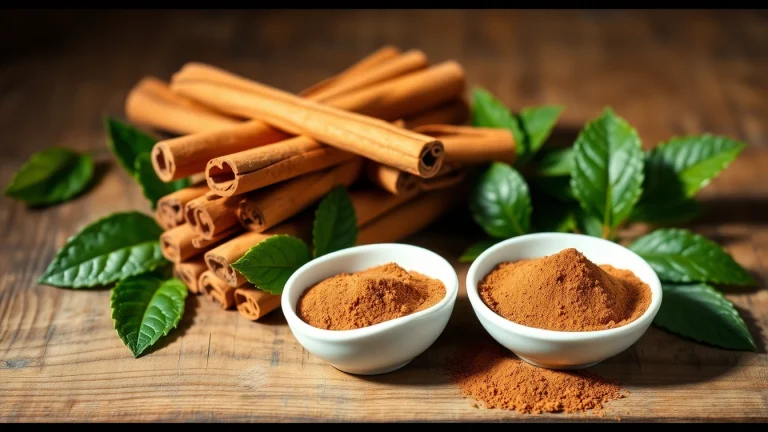
Benefits and Uses of Cinnamon Bark in Culinary and Health Applications
Understanding Cinnamon Bark
What is Cinnamon Bark?
Cinnamon bark is derived from the inner bark of trees belonging to the genus Cinnamomum. Renowned for its warm, sweet flavor and aroma, cinnamon has been used across cultures for thousands of years, not just as a culinary ingredient but also for its medicinal properties. Originating from tropical regions, the bark, once harvested, is dried and curled into quills or broken into smaller chunks, ready for use in various culinary and health applications. Among the most revered types of cinnamon is Ceylon cinnamon (also called “true cinnamon”), alongside the more common Cassia cinnamon. Both types have unique flavors and profiles, making cinnamon bark a versatile addition to any pantry, and can be explored in detail at Cinnamon Bark.
The Origin and Harvesting Process
The roots of cinnamon trace back to ancient Egypt, where it was valued for its aromatic qualities and used in embalming. Today, it primarily comes from countries like Sri Lanka, Indonesia, Vietnam, and China. The harvesting process involves carefully peeling away the outer bark of the cinnamon tree, revealing a softer, inner bark. This inner bark is collected, dried, and rolled into quills. The method of harvesting greatly affects the flavor and quality of the cinnamon, with the careful extraction being integral to producing high-grade Ceylon cinnamon as opposed to the thicker, more pungent Cassia.
Types of Cinnamon: Differences and Benefits
Understanding the different types of cinnamon is critical for both culinary and health purposes. The two main types, as previously mentioned, are Ceylon and Cassia. Ceylon cinnamon, characterized by its delicate, sweet flavor, is preferred for its complex aroma and is often considered healthier due to lower levels of coumarin, a compound linked to liver damage when consumed in large quantities. Cassia, on the other hand, is more common in grocery stores, recognized by its stronger, spicier flavor and thicker bark. While both types offer health benefits, Ceylon cinnamon’s superior qualities make it an excellent choice for those looking to maximize health benefits.
Health Benefits of Cinnamon Bark
Antioxidant Properties
Cinnamon bark is packed with powerful antioxidants, including polyphenols, which play a crucial role in protecting the body from oxidative stress. These antioxidants help neutralize free radicals, thus reducing inflammation and lowering the risk of chronic diseases such as heart disease, diabetes, and cancer. Regular consumption of cinnamon can improve overall health and promote longevity by combating inflammation and promoting cell health.
Anti-inflammatory Effects
Another significant health benefit of cinnamon bark lies in its anti-inflammatory properties. The natural compounds in cinnamon can act as potent anti-inflammatories, reducing swelling and discomfort associated with various inflammatory conditions. This feature is particularly beneficial for individuals suffering from arthritis or joint pain, as incorporating cinnamon into their diets may help alleviate symptoms.
Impact on Blood Sugar Levels
Numerous studies have highlighted cinnamon’s role in regulating blood sugar levels, particularly in people with type 2 diabetes. Cinnamon bark can enhance insulin sensitivity, allowing for better glucose uptake by cells, which can be crucial for managing diabetes symptoms. For those who are prediabetic or aiming to prevent diabetes, adding cinnamon to their diets may support better blood sugar control.
Culinary Uses of Cinnamon Bark
Spice Up Your Recipes: How to Use Cinnamon Bark
Cinnamon bark is a versatile ingredient that can enhance a variety of dishes. Whether used in its whole form, as quills, or ground into powder, cinnamon can add warmth and complexity to sweet and savory meals alike. From stews and curries to baked goods like cookies and pastries, cinnamon allows both novice and experienced cooks to explore diverse culinary avenues. Using whole cinnamon sticks in teas or infusions also provides an aromatic base for meals while allowing for easy removal once the desired flavor is achieved.
Classic Dishes Featuring Cinnamon Bark
Throughout history, many classic dishes have spotlighted cinnamon bark as a primary flavor. For instance, Moroccan tagines often incorporate cinnamon alongside fruits like apricots and almonds to create a harmonious balance of sweet and savory tastes. In American cuisine, cinnamon is synonymous with apple pies and pumpkin spice lattes, infusing these traditional recipes with a familiar warmth. Additionally, Middle Eastern cuisines often utilize cinnamon in savory dishes, showcasing its versatility across regions and cultures.
Cinnamon Bark in Beverages: Tea and Beyond
Cinnamon bark adds a unique flavor to various beverages as well. Cinnamon tea is a popular choice, particularly in colder months, providing not only warmth but also health benefits. Additionally, the spice is commonly used in warm drinks like chai lattes, hot chocolates, and even spiced wines during holiday seasons. Its inclusion on beverage menus brings a comforting familiarity that can elevate the overall experience of enjoying these drinks.
Buying and Storing Cinnamon Bark
What to Look for When Purchasing
When purchasing cinnamon bark, it’s essential to look for high-quality products that signify freshness and purity. Choose Ceylon cinnamon over Cassia when possible, as the former is often more aromatic, flavorful, and beneficial for health. When examining whole sticks, they should be thin and flexible, with a sweet aroma, while powdered cinnamon should be fragrant and free from additives. Look for reputable brands that guarantee freshness and quality, ensuring optimal flavor and health benefits.
Proper Storage Techniques
Correctly storing cinnamon bark can help maintain its flavor and potency. It should be kept in an airtight container, away from direct sunlight and moisture. A cool, dark cabinet works best for both ground and whole cinnamon bark. For maximum longevity, whole quills can last up to two years, while ground cinnamon may lose potency after six months if not stored properly.
Longevity and Freshness Tips
To ensure the freshness of cinnamon throughout its shelf life, consider buying smaller quantities more frequently, especially if you don’t use it often. Regularly checking for changes in aroma or flavor can indicate whether it has gone stale. Using a vacuum sealer or dark glass containers can also prolong the shelf life of this spice, allowing your culinary adventures to continue full steam ahead.
Conclusion: Incorporating Cinnamon Bark into Daily Life
Daily Intake Recommendations
Incorporating cinnamon bark into daily life can be straightforward and beneficial. For adults, approximately one teaspoon (2-4 grams) of powdered cinnamon or one whole stick daily can yield positive health effects, including improved blood sugar regulation and reduced inflammation. However, it’s essential to consider personal health conditions and consult with a healthcare provider when introducing any new dietary components.
Sustainability Considerations
When purchasing cinnamon, consumers should also consider sustainability. Harvesting practices can have a significant impact on the environment and local populations. Supporting companies that engage in ethical sourcing and sustainable agriculture can help protect delicate ecosystems, benefiting both consumers and producers. Being mindful of the environmental impact of cinnamon production not only promotes global health but also encourages responsible consumption.
Resources for Further Learning
For those wishing to delve deeper into the history, benefits, and culinary applications of cinnamon bark, numerous resources are available. Books on herbal medicine and culinary spices can provide more comprehensive guidance. Online platforms also host a wealth of information and community discussions around recipes, health benefits, and sourcing ethical ingredients. Engaging with these resources can enhance your understanding and appreciation of cinnamon, enriching your cooking and health practices.


